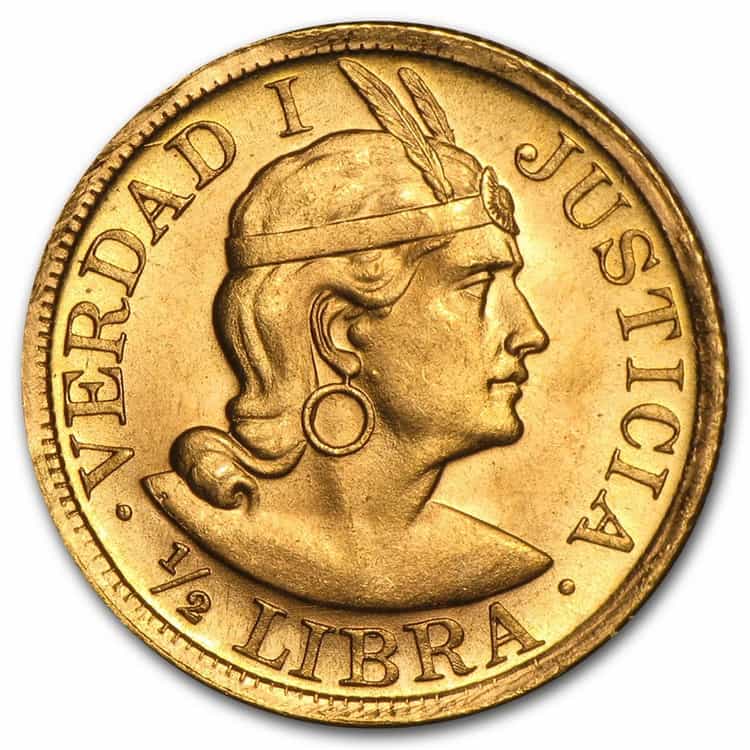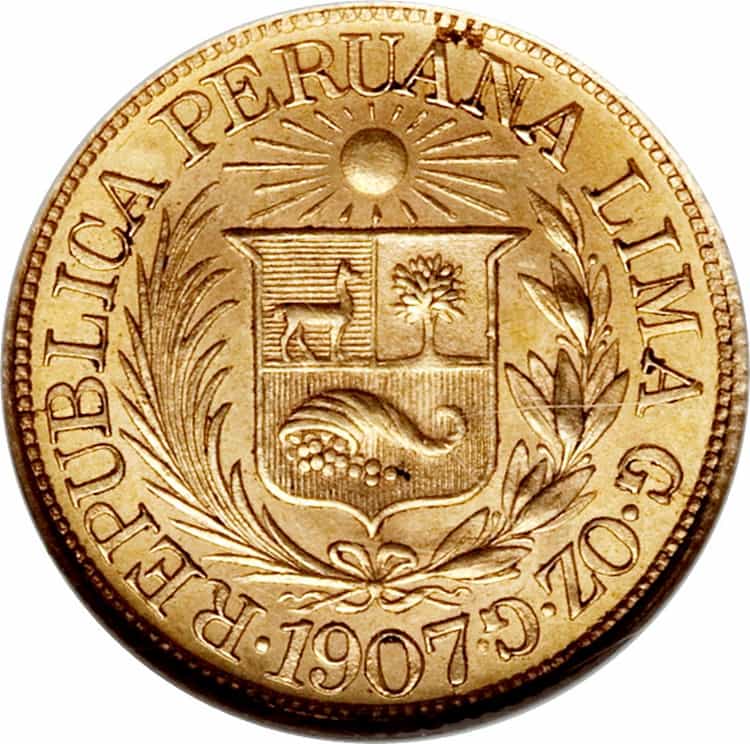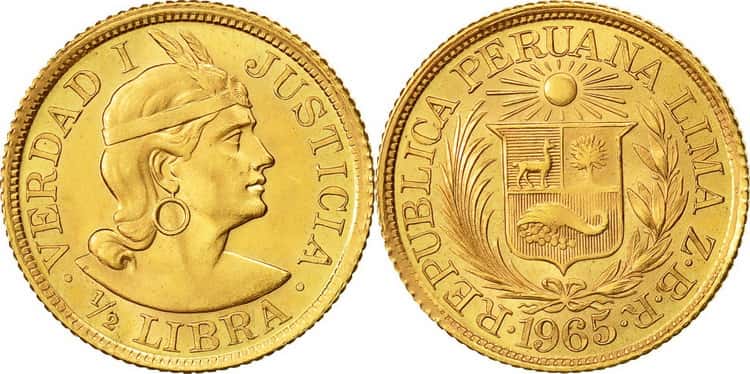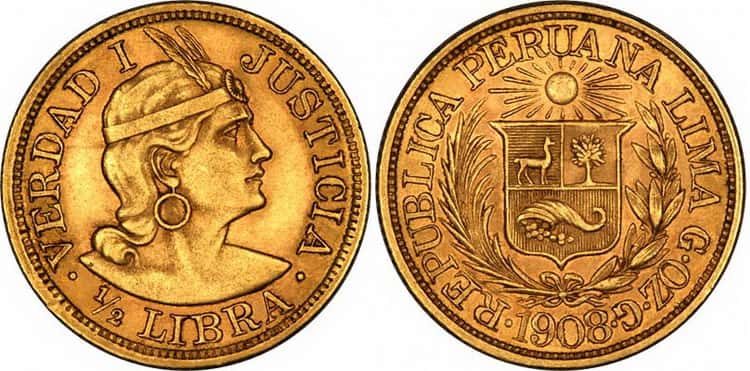
1/2 of the Peruvian Libra (1898−1969) is a series of gold coins created from the legendary Inca gold. In numismatics, they are among the most beautiful and rare coins in the world. The artistic value and impressive content of the precious metal became the main reason why collectors and investors are willing to buy these coins for a high price. All Peruvian gold coins in our catalog.
History
The gold of Peru, from which modern coins are minted, is a precious metal with a rich history. In ancient times, the Indians Inca, Mochi and Chimu, in contrast to European and Asian countries, did not use coins for trade. For these purposes, suitable “coins of the earth” − seeds, fruits, shells, coca leaves, and for larger transactions − pets.

Peruvian gold was available almost throughout the territory. Residents used it to create jewelry, decor and ritual objects. Jewelers of the pre-Inca and Inca era used a variety of techniques, including forging, lamination, filigree and polishing. Few things have survived to this day. Spanish conquistadors in Peru melted jewelry into ingots, and then sent them home. One of the lost treasures are openwork butterflies of gold, which could soar in the air for some time. You can find all 1/2 Libra Peruvian gold coins in our catalog.
Did you know? In the XVII−XVIII centuries in Peru, the measurement system was octal (as in Spain and in all the Spanish colonies), and not decimal, as they are used to in modern times. Only with the advent of the gold standard, gold coins of 1 libra and ½ libra denomination were equated to silver sol (10 soles and 5 soles, respectively). All Peruvian silver coins in our catalog. The denominations of Spanish coins before the currency reform in the octal system were from ¼ to 8 reals. The last 8 reals of Peru were minted at Pasco in 1857. Then the government of Ramón Castilla changed the monetary system from octal to decimal, so that 1 peso consisted of 10 reals instead of 8.
Since the foundation of Lima (1535), the Spanish conquistador Francisco Pizarro y González understood that it was quite difficult to make any commercial transactions without an established monetary system. At that time, gold and silver bars were used only for large trading operations, but this method was not effective for small transactions. To simplify the task, they first allowed to produce coins made of precious metals. But the currency caused chaos, because in private Mint there was no single standard and the money differed in weight, size and denomination.

The Spanish Crown realized the importance of minting their own coins in Peru. In 1565, the State Mint was built in Lima. It was assigned an important role, which was to organize and standardize the previous currency, to withdraw illegal coins from circulation. The implementation of these actions was to ensure political and economic stability in the country. The Lima Mint in Peru became the first in South America and the third in all of Spanish America.
Did you know? The Peruvian libra coins of 1 and ½ denomination could appear earlier. General San Martín (one of Peru’s liberators) ordered the minting of samples entitled “Peru Libre” (“Free Peru”), so that they could gradually replace those with the bust of the Spanish monarch Ferdinand VII. As silver reserves declined, an attempt was made to introduce banknotes and copper coins, but people rejected them. The banknotes had a weak design, so they could easily be faked. In response to the refusal in 1822, the government entered into a debt agreement with London creditors. These funds were used to continue the war against Spain.
During the period of Spanish colonization, the Mint of Lima produced the main Peruvian gold and silver coins real, peso and escudo. After the Peruvians managed to get rid of the centuries−old European rule, for a long time they could not produce their own currency. The war of independence brought serious losses to the Mint. The equipment was seriously damaged, many qualified staff left Lima after the events of 1821.

In 1863, the new government managed to conduct a monetary reform. The Lima Mint began minting the first national currency. Silver sol (1863−1985) and centavo served as change coins. For international trade were intended 1/2 and 1 Peruvian libra (1898−1969). All 1 Libra Peruvian gold coins in our catalog. At that time, due to the unstable economy, many states, including the United Kingdom and the United States, refused to accept banknotes. The Mint produced a small amount of coins, but this circulation was enough for annual trade operations between countries.
Did you know? The highlight of all Peruvian coins, including ½ libra, is the symbol of “sun” (also used in the Argentine escudo). When the coins of Peru stopped minting the bust of Emperor Ferdinand VII, the new government chose the image of the sun, because it was associated with the ancient Inca faith and new republican ideals.
The basis of 1/2 of the Peruvian libra was the British gold standard (used by other countries, such as India and Australia). From 1885 to 1913, it ranked second as the coin with the largest denomination in Peru (first place is 1 Peruvian libra). The gold of high standard was used (917/1000). The coins had an impressive weight (56 grains = 3.994 grams), like the British sovereign. The currency symbol made the sign “Lp”.
When the world crisis began in 1929, the United States and Europe abandoned the gold standard. The Lima Mint continued production of 1/2 libra. This feature made the Peruvian currency of the years 1898−1969 demanded among collectors from a historical point of view.
Design
At all times, carvers and engravers held a special place in the work of the Mint of Lima. Specialists were responsible for the design of coins and medals, as well as their artistic value. The Peruvian libra design of 1/2 denomination belongs to the outstanding masters Armando Pareje and Raymond Pelletier.
Characteristics of Peruvian 1/2 libra

- Material: gold.
- Ingredients: 917/1000.
- Weight: 3,994 grams.
- Net weight: 3.665 grams.
- Diameter: 19 mm.
- Thickness: 1.25 mm.
Obverse: The front side is decorated in the center with the national emblem of Peru. To the left and to the right of it are located the branches of the trees − palm and laurel, and above there is the sun with rays. The legend says “REPUBLICA PERUANA LIMA G • OZ • G” around a circle, the year of the issue is indicated at the bottom.
Did you know? Before adopting the gold standard of Great Britain, Peru and other silver producers, such as Mexico, the USA and Russia, for several years resisted the adoption of a new standard, but eventually abandoned bimetallism.
Reverse: On the reverse side in the center there is a portrait of an Indian with a face turned to the right. According to legend, the image of Manco Capac is the first Inc. of Peru and the leader of a kind. The inscription “VERDAD I JUSTICIA” was struck to the left and to the right of it. On the bottom edge is the denomination of the coin “1/2 LIBRA”.
Circulation
1/2 of the Peruvian libra was issued in a very small circulation. At the same time, only 4 times in the entire history of minting, the figure exceeded 10,000 pieces. The largest circulation was released in 1966 and amounted to 44,000 coins. In 1907, 1909−1952, 1954, 1956−1960 and 1967, gold coins of this series were not minted.
The coins were minted during the period from 1902 to 1969:
- 1902 − 7 800 pcs.
- 1903 − 7,245 pcs.
- 1904 − 8,360 pcs.
- 1905 − 8,010 pcs.
- 1906 − 9,176 pcs.
- 1908 − 8,180 pcs.
- 1953 − 9,210 pcs.
- 1955 − 14,000 pcs.
- 1961 – 752 pcs.
- 1962 − 4,286 pcs.
- 1963 − 908 pcs.
- 1964 − 10,000 pcs.
- 1965 − 5,490 pcs.
- 1968 − 14,000 pcs.
- 1969 − 4,400 pcs.
The cost of coins
The price of 1/2 Peruvian libra depends on the current value of gold on world markets and the degree of preservation. Coins as VF cost from $ 80 at auctions. If the quality is higher, then the price rises up to $200.
Comments
No commens yet.